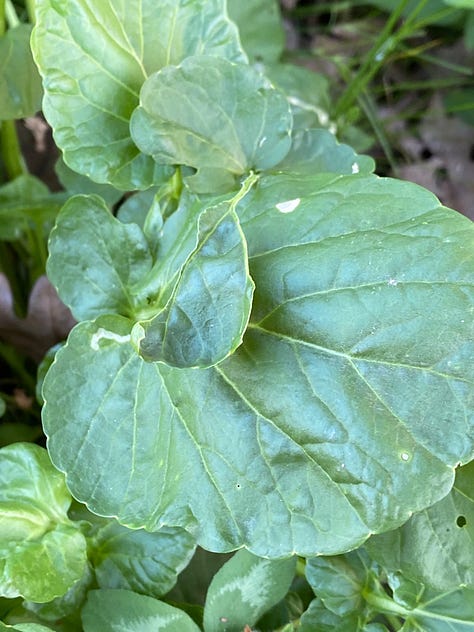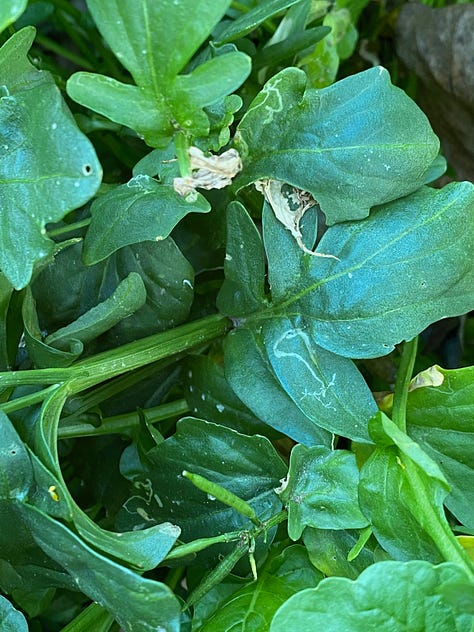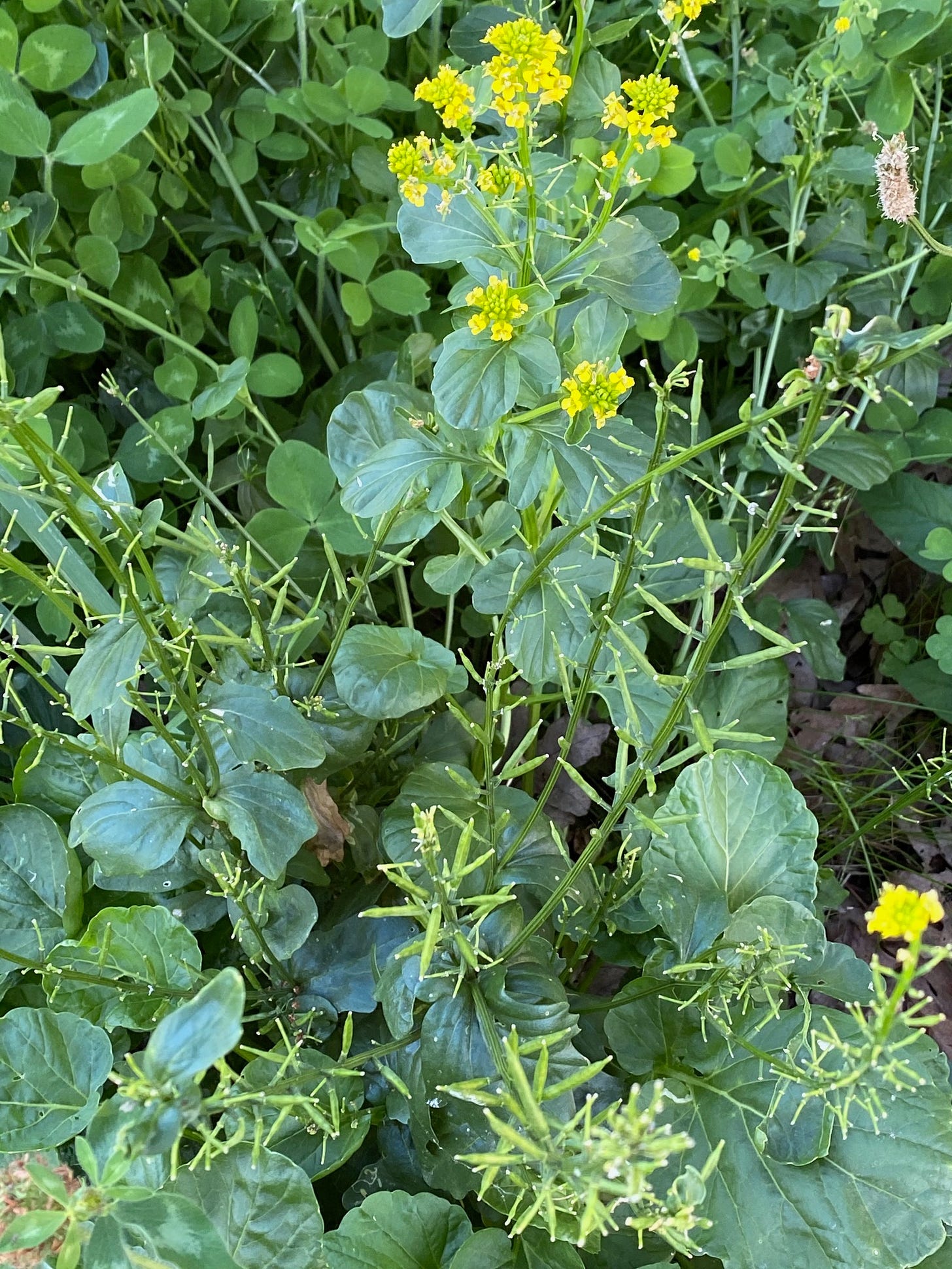Wintercress, or Barbarea vulgaris, is an edible weed which faithfully stays with us through the winter. It therefore deserves some promotional services at Weedom. It’s a family member of the Brassicaceae, named after St. Barbara, the patron saint of miners, and the ‘vulgaris’ term means that it’s everywhere, “common”. The story is that this plant was once used for wound care, most particularly for miners suffering from serious job hazards. It has also been known for diuretic and anti-scorbutic properties (prevents scurvy due to vitamin C content), and it’s a strong source of vitamin A. Other names for this plant are yellow rocket, wound rocket, rocket cress, Herb Barbara, and bittercress (this last name can cause confusion with Cressida species ).
Our pharmacognosy friends in the Middle East, Eastern Europe, and India haven’t been digging into this plant so much, so that its constituents have not been exhaustively enumerated. Despite claims that Wintercress can be potentially poisonous, (as are all plants eaten by the bale), case reports are not emerging thus far. Livestock which overdose on this plant can suffer toxicity, attributed to glycosinolates or nitrates within the plant. Saponins have also been blamed for toxicity, and this appears more certainly to be the case for insects. At Weedom, our interest in this weed is mainly as winter greens, because the rosette of leaves actually tastes good when harvested in cold weather. As weather warms up, bitterness increases, but this can be fixed by dropping the leaves in boiling water for just a minute or two, then rinsing with cold water to stop the cooking. If you eat cabbage or collards, you’ll get along with wintercress. If you’re trying to save your cruciferous garden vegetables from being eaten by those eeeeevil moth and cabbage fly worms, wintercress has further utility. More on that later.
Wintercress is native to Europe, Mediterranean countries and Japan, and is doing quite well as a “pernicious” weed in our Midwest U.S.A.. Find it in moist soil along ditches, roadsides, streams, hedges, and well watered fields. It’s hardy from Zones 5a thru 9b, so many of you can enjoy it as greens throughout the winter. As a biennial it usually spends year 1 as a rosette of leaves, then bolts up in year 2 up to perhaps a meter high forming copious yellow flowers, and elongated seed pods that might offer about 10,000 seeds per plant.
It’s time to find some wintercress while it still tastes best. If you remember last spring and summer seeing some 2 to 3 foot high plants covered in small, bright yellow flowers, and very thin green pods about an inch or so long, that’s where to go looking for the rosettes now. Look for lobed glossy, deep green leaves 3 to 6 inches long and 1 to 3 inches wide. There are 2 to 4 pairs of alternate lobes, and a wide single lobe at the end of each compound leaf. Each leaflet of the compound leaf has palmate vein pattern. Most of these plants have glabrous (hairless) leaves but there is a (arguable) subtype of the species which does have hairs. The leaves are thick and a bit rubbery in texture, like those of very healthy plantain.



Flowers have 4 petals and 4 sepals in a cross configuration, like the other “cruciferous” plants. Each flower has 6 anthers and 1 pistil, and is borne on a short hairless stalk. Leaves emerge directly from the stem as it rises from the base. (No petioles) They become smaller and narrower higher on the stem, near the blooms. Clusters of buds can be harvested before they flower, and steamed or cooked like broccoli. Don’t eat the seeds of either plant. A couple of similar edible plants grow in the U.S. One is Barbarea verna, often called creasy greens or land cress, which grows more often in the Southeastern U.S., but can be found in the Midwest. Its basal leaves generally have more pairs of lobes. Land cress has been packed in cans with salt and pork fat, and sold as ‘Betty Ann Creecy Greens’, up until about 10 years ago. Barbarea orthoceras, a.k.a. American wintercress grows further north and into Canada. There’s an argument as to whether there is a hairy subspecies of Barbarea vulgaris, or if it is actually a separate species, called Barbarea stricta.
Friends of the Eloise Butler Wildflower Garden have the best closeup details of Barbarea vulgaris in top quality pics. Another good set of healthy Missouri wintercress is pictured here.
We promised to tell you about companion planting as a natural way to keep bugs off of cultivated brassica species. The studies of plant chemistry have focused on glucosinolates that wintercress puts out to attract diamondback moths (Plutella xylostella L.) to lay their eggs. This creates a sort of dead end problem for those insects, because their larvae don’t do so well when eating this plant, due to its toxic saponins. The plus is that the moths are less likely to lay their eggs on whatever cabbage, broccoli or collards are growing nearby, and their wormy little larvae die when they eat the wintercress. The noxious cabbage white butterfly (Pieris rapae) is able to detect the glucosinolates put out by wintercress, but the larvae are resistant to the saponins, so this plant might serve as an alternative food for those little green cabbage worms, but it won’t kill them. Permaculturalists are finding that the flowering stage of wintercress is less toxic to the diamondback moth, but it attracts certain wasps which parasitize the larvae. Therefore, having both the first year and the second year plants brings some benefit as companion plants. A 2009 Danish study identified 4 saponins which appeared to be responsible for resistance of Barbarea vulgaris to the flea beetle (Phyllotreta nemorum) larvae. More death syndrome for garden pests. ;-)
Remember wintercress as a means of getting some greens and vital nutrients throughout the winter, when little else grows. It tastes pretty good in the cold weather, but be sure to blanch or boil the leaves for a short time if you harvest it in warmer weather. The softer stems plus flower buds can be cooked to supply a strong tasting substitute for broccoli. Consider trying it as a companion plant to help protect the cruciferous vegetables in your garden, perhaps in a corner upwind from your cabbage patch.
We’ll be updating pictures in our previous posts as we watch our weeds grow, so that more of their lifecycles are illustrated with less dependency on links. For example, seed pods are added to Shepherd’s purse 1 and blooms are added to Chickweed 1. We really want you to find those weeds.
Feel free to comment, tell us what you’re doing with your weeds, and which midwestern plants you think we should cover in the future. Please share this free resource with whomever might benefit. Thanks for spending time with us!
Where we dig
1. Lansdown RV. Barbarea vulgaris. IUCN Red List of Threatened Species. 2014;2014:e.T176585A42338497. doi:10.2305/IUCN.UK.2014-1.RLTS.T176585A42338497.en
2. Barbarea vulgaris (Bittercress, Garden Yellowrocket, Herb Barbara, Rocketcress, Wintercress, Winter Rocket, Wound Rocket, Yellowrocket, Yellow Rocket, Yellow Rocketcress) | North Carolina Extension Gardener Plant Toolbox. Accessed March 19, 2023. https://plants.ces.ncsu.edu/plants/barbarea-vulgaris/
3. Barbarea vulgaris Yellow Rocket, Garden yellowrocket PFAF Plant Database. Accessed March 19, 2023. https://pfaf.org/user/plant.aspx?LatinName=Barbarea+vulgaris
4. Companion Planting with Land Cress for Natural Caterpillar Control – Deep Green Permaculture. Accessed March 21, 2023. https://deepgreenpermaculture.com/2020/08/25/companion-planting-with-land-cress-for-natural-caterpillar-control/
5. Senatore F, D’Agostin M, Dini I. Flavonoid Glycosides of Barbarea vulgaris L. (Brassicaceae). J Agric Food Chem. 2000;48(7):2659-2662. doi:10.1021/jf990625k
6. Kuzina V, Ekstrøm CT, Andersen SB, Nielsen JK, Olsen CE, Bak S. Identification of Defense Compounds in Barbarea vulgaris against the Herbivore Phyllotreta nemorum by an Ecometabolomic Approach. Plant Physiology. 2009;151(4):1977-1990. doi:10.1104/pp.109.136952
7. Gamble M. Land Cress. Our Permaculture Life. Published July 23, 2017. Accessed March 21, 2023. https://ourpermaculturelife.com/land-cress/
8. Nutrition: The Wonders of Winter Cress | Suburban Foragers. Accessed March 21, 2023. http://www.suburbanforagers.com/2012/04/11/nutrition-the-wonders-of-winter-cress/
9. Small-flowered Wintercress, Barbarea stricta - Flowers - NatureGate. Accessed March 20, 2023. https://luontoportti.com/en/t/31/small-flowered-wintercress
10. Spring into wintercress | Wild Food Girl. Published May 9, 2015. Accessed March 20, 2023. https://wildfoodgirl.com/2015/a-summer-for-ickycress/
11. Byrne SL, Erthmann PØ, Agerbirk N, et al. The genome sequence of Barbarea vulgaris facilitates the study of ecological biochemistry. Sci Rep. 2017;7(1):40728. doi:10.1038/srep40728
12. Badenes-Perez FR, Reichelt M, Gershenzon J, Heckel DG. Using plant chemistry and insect preference to study the potential of Barbarea (Brassicaceae) as a dead-end trap crop for diamondback moth (Lepidoptera: Plutellidae). Phytochemistry. 2014;98:137-144. doi:10.1016/j.phytochem.2013.11.009
13. Weekly Weeder #20 – Winter Cress + Wildcrafting Wednesday. Accessed March 21, 2023. https://commonsensehome.com/winter-cress/
14. WHATGOTGATHERED. Wintercress. What Got Gathered. Published March 1, 2020. Accessed March 21, 2023. https://whatgotgathered.com/2020/03/01/wintercress/
15. Wintercress, Barbarea vulgaris - Flowers - NatureGate. Accessed March 20, 2023. https://luontoportti.com/en/t/210/wintercress
16. Yellow Rocket // Mizzou WeedID. Accessed March 20, 2023. https://weedid.missouri.edu/weedinfo.cfm?weed_id=36
17. Bergo A. Yellow Rocket or Wintercress (Barbarea vulgaris). Forager | Chef. Published April 7, 2019. Accessed March 19, 2023. https://foragerchef.com/barbarea-vulgaris-bittercress-wintercress/
18. Yellow Rocket, Barbarea vulgaris R.Br. Accessed March 19, 2023. https://www.friendsofthewildflowergarden.org/pages/plants/yellowrocket.html
19. Yellow Rocket: Pictures, Flowers, Leaves & Identification | Barbarea vulgaris. Accessed March 20, 2023. https://www.ediblewildfood.com/yellow-rocket.aspx








So interesting, I appreciate the amount of knowledge it takes to know how different plants can be used.
I meet with a group of friends I made during covid and we've been sharing information like this. I don't know hardly anything myself. My friend has been making tea out of the weeds that are easy to pull out of the ground and they have a whole network of weed connected. I forget what they're called, but I like the tea, it's energy feels good.